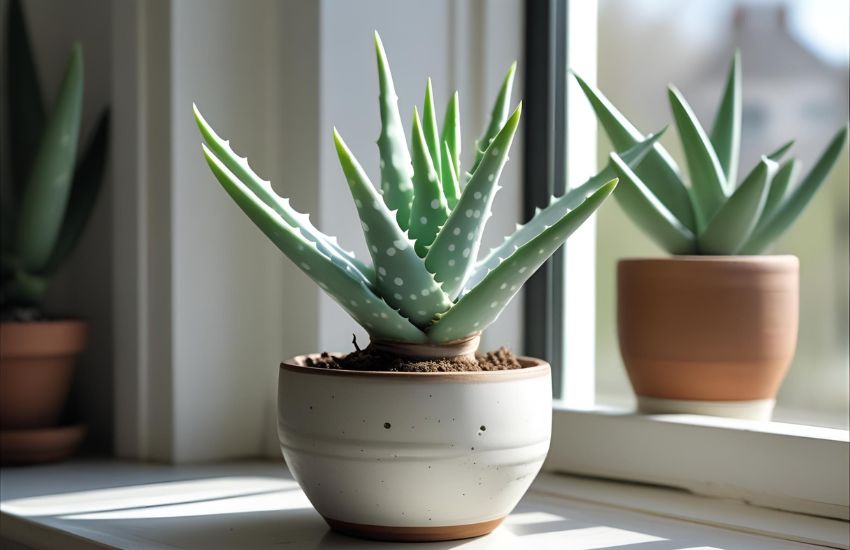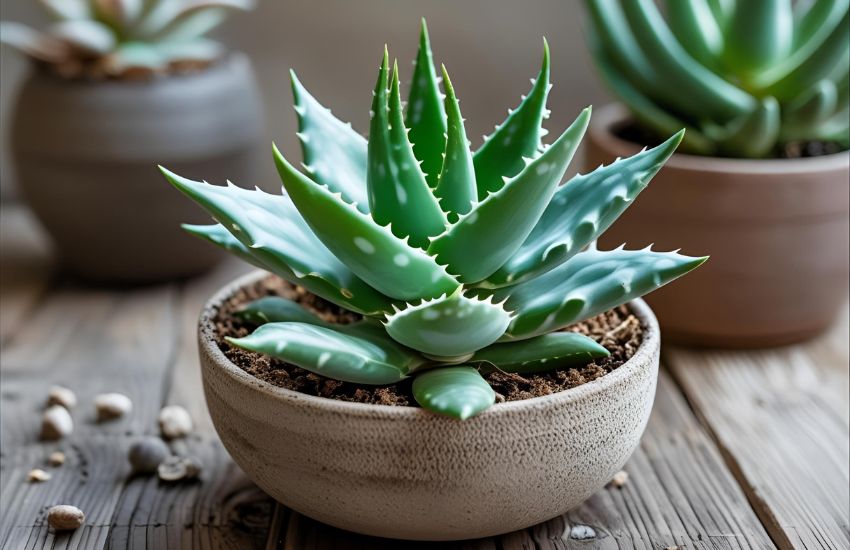Looking for a compact, stylish houseplant that’s easy to care for and adds a fresh, green touch to your indoor space? The Aloe Vera Mini Plant offers exactly that—vibrant charm, low-maintenance care, and impressive resilience. Known botanically as aloe barbadensis, this succulent is not just a decorative addition; it also holds powerful medicinal value, especially when the gel from its plant leaves is used for soothing burns or skin irritations.
Aloe Vera Mini Plant is a beginner-friendly succulent that adds style and greenery to your indoor pots. With its compact size, low-maintenance nature, and soothing gel-filled leaves, it thrives near a sunny window or balcony. Ideal for modern spaces, it brings beauty and wellness together—perfect for new plant lovers and urban gardeners alike.
In this blog, you’ll discover why this beginner-friendly houseplant is a favorite at places like Home Depot, how to care for it to help it thrive, and what makes its genus so adaptable. We’ll also explore how to handle pups, propagation, and where these plants truly shine.
Aloe Vera Plant Care: Best Soil, Water, and Pot Tips

- Soil & Potting Mix:
Use a well-draining succulent mix or cactus potting mix to prevent excess moisture. Aloe Vera is highly susceptible to root rot, so excellent drainage is key to its health. - Pot Selection:
Choose a terracotta or clay pot with drainage holes. The diameter of the pot should be just slightly larger than the plant’s base to avoid water accumulation and support the formation of many pups for future propagation. - Watering Needs:
Water deeply but infrequently. During spring and summer, water only when the soil is completely dry. Reduce watering during colder months. Always avoid leaving the roots soggy. - Lighting Conditions:
Place your aloe in bright light, such as near a sunny window. Though native to southern Africa, avoid intense midday rays indoors to prevent leaf burn. A well-lit location helps maintain the upright, symmetrical rosette form. - Growth Habit:
Aloe Vera is a slow growing, miniature plant that can reach just a few inches tall. Its fleshy, toothed leaves are arranged in a rosette and store the plant’s soothing gel within the stem and foliage. - Fertilizer Use:
Feed lightly with a succulent-specific fertilizer once every 4–6 weeks during the growing season (spring and summer). Overfeeding can damage the plant. - Propagation Tips:
Look out for many pups growing around the base. These offshoots can be gently separated and potted on their own—a great way to multiply your collection through propagation. - Botanical Background:
Aloe Vera belongs to the Asphodelaceae family and is part of a broader succulent genera. It’s a popular houseplant due to its ease of care, adaptability to various zones, and easy to grow nature. - Decorative Benefits:
Its compact size and attractive shape make Aloe Vera a decorative choice for shelves, windowsills, or desks, all while offering functional beauty with its medicinal properties.
Aloe Plant Propagation Guide: Grow and Multiply with Ease Indoors

Propagating your Aloe Vera plant is a satisfying and simple process, especially when done indoors. Whether you’re a beginner or an experienced indoor gardener, knowing how to expand your aloe collection using natural offshoots can help you grow a healthy group of plants while maintaining the integrity of the original.
Understanding Aloe’s Growth and Natural Habitat
Also known as aloe, Aloe Vera is a versatile succulent native to regions such as Kenya, where it thrives in arid environments with plenty of light and minimal rainfall. In its native habitat, it grows in clusters, naturally producing offsets, or pups, at the base of the main plant. These offsets are the key to successful propagation indoors.
When and How to Propagate Aloe Vera
The best time to propagate aloe is during its active growth period, typically in spring or early summer. Look for a mature aloe plant with healthy pups forming around the base. Each offset should have its own small root system before removal.
To begin, gently remove the parent plant from its pot and separate the pup using a clean, sharp knife if necessary. Let the pup dry for 24–48 hours before planting it into well-drained soil, which is crucial to prevent overwatering and eventual root rot.
Ideal Light and Watering Conditions
Place the new plant in a space with bright but indirect light conditions. Although aloe can tolerate a range of indoor lighting, insufficient light will slow growth. Be cautious with waterings—allow the soil to fully dry between sessions, as aloe stores moisture in its leaves and is sensitive to excess water.
Indoor Climate and Temperature Tips
Aloe Vera prefers warm indoor temperatures and cannot withstand frost. Keep your propagated aloe in a stable, warm room free from drafts. Avoid placing it too close to cold windows during winter months.
Aesthetic and Functional Value
In addition to its cosmetic and healing benefits, aloe makes a striking ornamental plant. Its tall, tubular flowers (when blooming) and sculptural foliage add elegance to any room. With proper care, your propagated aloe can thrive for years while beautifying your space and providing practical uses.
Conclusion
Caring for and propagating an Aloe Vera Mini Plant indoors is both rewarding and refreshingly simple. This low-maintenance succulent is far from fussy, thriving in bright light, minimal rainfall, and warm temperatures—ideally above 55°F. Its thick, unbranched leaves are filled with healing sap that contributes to the plant’s well-known medicinal properties, making it as functional as it is beautiful. With its bold foliage, sometimes accented by a faint stripe or reddish tint under stress, aloe adds an abundant visual appeal to your indoor garden. During the warmer months, its growth and ability to produce pups increase, giving you more opportunities to multiply your collection.
With just the right care and attention, your aloe’s striking foliage will continue to thrive year-round. Now is the perfect time to start or expand your aloe collection. Take the next step—choose a healthy aloe, follow the propagation guide, and bring more life and wellness into your home.
Frequently Asked Questions (Aloe Vera Mini Plant: A Beginner-Friendly Succulent for Stylish Indoor Pots)
Is aloe vera a good beginner plant?
Yes, aloe vera is an excellent plant for beginners. It requires minimal care, thriving in bright, indirect sunlight and well-drained soil. With infrequent watering and low maintenance needs, it’s perfect for busy or novice plant owners. Additionally, its air-purifying qualities and soothing gel make it both a practical and decorative addition to any home.
Can aloe vera grow in small pots indoors?
Yes, aloe vera can grow well in small pots indoors as long as the pot has good drainage. Use a well-draining succulent or cactus soil mix to prevent root rot. Place it in a bright spot with indirect sunlight, and water sparingly. Repot the plant as it grows to ensure healthy root development.
Is aloe vera lucky inside the house?
Yes, aloe vera is often considered a lucky plant to keep inside the house. It is believed to attract positive energy, good health, and prosperity. Besides its symbolism, aloe vera also purifies the air and creates a calming environment. Placing it near windows or entryways is thought to enhance its protective and luck-bringing properties.
What is the easiest plant to maintain indoors?
The easiest plant to maintain indoors is the Snake Plant (Sansevieria). It thrives in low to bright light, requires minimal watering, and tolerates neglect well. Its air-purifying qualities make it perfect for any room. With its hardy nature and low maintenance needs, the snake plant is ideal for beginners and busy individuals.
